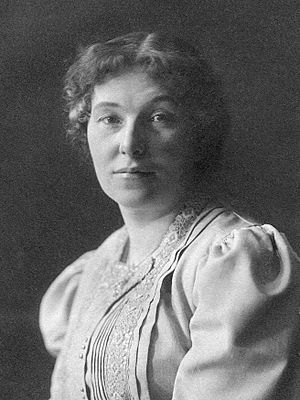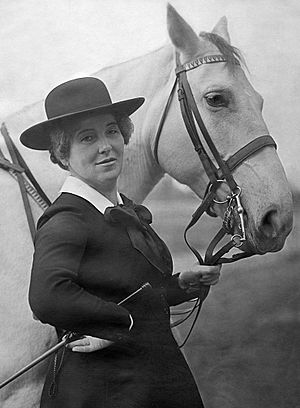Clara Viebig facts for kids
Clara Emma Amalia Viebig (born July 17, 1860 – died July 31, 1952) was a famous German writer. She wrote many novels and stories.
Contents
Her Life Story
Clara Viebig was born in Trier, a city in Germany. Her father worked for the government in Prussia, which was a large part of Germany at the time. When she was eight, her family moved to Düsseldorf. Clara went to school there. She loved visiting the beautiful Moselle river area near Trier, where she often went for walks.
After her father passed away, she lived with relatives in Posen. Later, when she was twenty, Clara moved to Berlin with her mother. She originally planned to study music in Berlin. However, the exciting city and all the places she had seen inspired her to become a writer instead.
In 1896, Clara married Fritz Theodor Cohn, who was a book publisher. The next year, she started her successful writing career, and people really admired her books. After getting married, she mostly lived in Berlin and its nearby towns.
Her Book Das Schlafende Heer
One of Clara Viebig's most well-known novels was Das Schlafende Heer, which means "The Sleeping Army." It was published in 1903. In this book, Viebig wrote about German settlers moving into areas that were once part of Poland. She also shared concerns about Polish people living in Germany. She suggested that if these issues were not managed, the Polish population might become too large for Germany.
This viewpoint was common in Germany at the time. Her book was part of a literary style called Heimatkunst, which focused on regional themes. Das Schlafende Heer became a huge bestseller in the German Empire in 1904 and 1905. It was one of her most widely read novels.
In Das Schlafende Heer, Clara Viebig described differences between Poles and Germans. She focused on Polish women characters, suggesting they were planning against German men. She also wrote that Poles lived in a "wild" state, and that only German influence could "civilize" them. The book suggested that settling German people in these areas was the answer. A researcher named Kristin Kopp from the University of Missouri says that Viebig's novel is an important example of how some stories presented Polish characters as appearing one way on the outside, but being portrayed as different on the inside, which allowed them to seem to fit into German culture while secretly working against German plans.
Later in Her Career
As Clara Viebig's fame started to fade, she published a book called Insel der Hoffnung ("Island of Hope") in 1933. This book criticized the Weimar Republic (the German government at the time) and supported the idea of Germans settling along the border with Poland.
However, in 1936, her books were banned by the Third Reich (the Nazi government) because her husband was Jewish. Even though her husband was Jewish, Clara Viebig herself was not harmed because she was related to Hermann Göring, a powerful Nazi leader. In 1937, she moved to Brazil for a year. She returned to Germany a year later and tried to fit in with the Nazi government. Her books continued to be published, but not as often.
On her 80th birthday in 1940, the newspapers and Nazis celebrated her work. Das Schlafende Heer was even praised by Nazi critics as an important book about "national struggle." While her books were different from the extreme racist Nazi literature, her letters show she kept some distance from Nazism. However, her writings often showed a strong nationalist spirit and some ideas similar to other German nationalist movements.
Her Works
Novels
- Dilettanten des Lebens, 1897
- Rheinlandstöchter, 1897
- Vor Tau und Tag, 1898
- Dilettanten des Lebens, 1899
- Es lebe die Kunst, 1899
- Das Weiberdorf, 1899
- Das tägliche Brod, 1900
- English edition: Our Daily Bread, 1909
- Die Wacht am Rhein, 1902
- Vom Müller Hannes, 1903
- Das schlafende Heer, 1904
- English edition: The Sleeping Army, 1929
- Einer Mutter Sohn, 1906
- English edition: The Son of his Mother, 1913
- Absolvo te!, 1907
- English edition: Absolution, 1908
- Das Kreuz im Venn, 1908
- Die vor den Toren, 1910
- Das Eisen im Feuer, 1913
- Eine Handvoll Erde, 1915
- Töchter der Hekuba, 1917
- English edition: Daughters of Hecuba, 1922
- Das rote Meer, 1920
- Unter dem Freiheitsbaum, 1922
- Menschen und Straßen, 1923
- Die Passion, 1925
- Die goldenen Berge, 1928
- English edition: The Golden Hills, 1928
- Charlotte von Weiß, 1929
- Die mit den tausend Kindern, 1929
- English edition: The woman with a thousand children, 1930
- Prinzen, Prälaten und Sansculotten, 1931
- Menschen unter Zwang, 1932
- Insel der Hoffnung, 1933
- Der Vielgeliebte und die Vielgehaßte, 1935
Short stories & novellas
- Kinder der Eifel, 1897
- Vor Tau und Tag, 1898
- Die Rosenkranzjungfer, 1900
- Die heilige Einfalt, 1910
- Heimat, 1914
- West und Ost, 1920
- Franzosenzeit, 1925
Plays
- Barbara Holzer, 1896
- Die Pharisäer, 1899
- Kampf um den Mann, 1903
- Das letzte Glück, 1909
- Pittchen, 1909
See also
 In Spanish: Clara Viebig para niños
In Spanish: Clara Viebig para niños




